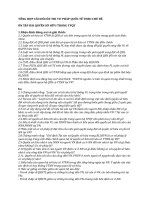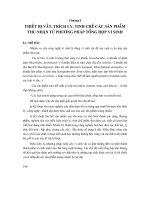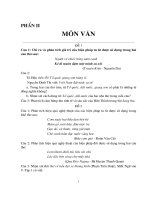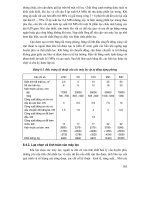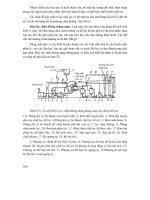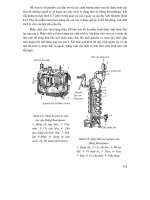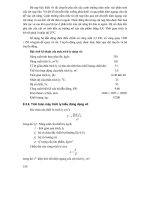- Trang chủ >>
- Đề thi >>
- Đề thi lớp 7
Ngu phap tong hop Cau che Lien tu
Bạn đang xem bản rút gọn của tài liệu. Xem và tải ngay bản đầy đủ của tài liệu tại đây (43.43 KB, 6 trang )
<span class='text_page_counter'>(1)</span>Câu chẻ (cleft sentence) Cấu trúc chung: It + (be) + sb/sth + that S+V+O. Ex: My transporter sent the money to Mrs. Amanda yesterday. + Muốn nhấn mạnh chủ ngữ “My transporter” (subject focus) => It was my transporter that/who sent the money to Mrs. Amanda yesterday. + Muốn nhấn mạnh vị ngữ (hay còn gọi là tân ngữ) “the money” (object focus) => It was the money that my transporter sent to Mrs. Amanda yesterday. *Note: Phần này sẽ được mở rộng thêm bằng cách dùng cấu trúc bị động. + Muốn nhấn mạnh vị ngữ “Mrs. Amanda” => It was Mrs. Amanda that my transporter sent the money to yesterday. *Note: Cũng có bị động + Muốn nhấn mạnh trạng ngữ (adverbial focus) => It was yesterday that my transporter sent the money to Mrs. Amanda. Để ý, tất cả những câu trên đều bắt đầu bằng “It”. Tham khảo thêm phần phủ định và nâng cao trong sách. ______ Phần tiếp theo này sẽ có “cụm mở đầu” dành riêng cho từng chủ ngữ/vị ngữ/trạng ngữ/… Người Vật Địa điểm Thứ, ngày, tháng năm. The person who The thing that/What The place where Thứ, ngày, tháng, năm + (be) + when/that. Ex: John has a computer in his room. John is the person who has a computer in his room. The person who has a computer in the room is John. The thing that/What John has in his room is a computer. The place where John has a computer is in his room. Ex: Nick went to school on last Saturday. It was Saturday that/when Nick when to school. Cấu trúc bị động trong câu chẻ:.
<span class='text_page_counter'>(2)</span> It + (be) + Túc từ (Object) + that + (be) + V 3/ed. Ex: My transporter sent the money to Mrs. Amanda yesterday. It was the money that was sent to Mrs. Amanda yesterday by my transporter. It was Mrs. Amanda who was sent the money to by my transporter yesterday. ______. Liên từ: + both … and +not only … but also. +either … or +neither … nor. **Cái đầu tiên phải nhớ là: trong 3 cấu trúc either … or, not only … but also, neither … nor động từ được chia theo chủ từ thứ 2 ( Subject 2). Ex: Not only we but also my sister loves flowers. Either we or my sister loves the flowers. Neither we or my sister wants to go home. **Riêng both … and thì dùng động từ chia ở số nhiều. Ex: Both my brother and my sister are going on a holiday. Both the teacher and the pupils are in the class. Both … and He is both handsome and intelligent. He wants both love and properties. He is both walking and eating.. (Tính từ và tính từ) (Danh từ và danh từ) (Động từ và động từ). Luôn có quan hệ song song, trước “and” là từ loại gì thì sau “and” là từ loại đó. (Trừ Standard English) Cấu trúc:. both … and -S + (be) + both + adj + and + adj He is both handsome and intelligent. -S + (động từ) + both + N + and + N He wants both love and properties. -S + (be) + both + V-ing + and + V-ing He is both walking and eating. -Both + N + and + N + động từ số nhiều (plural verb) Both my brother and my sister are going on a holiday..
<span class='text_page_counter'>(3)</span> not only … but also -S + not only + (động từ) + but also + đọng từ He not only sings but dances very well. -S + (be) + not only + tính từ + but also tính từ He is not only handsome but also intelligent. **Cấu trúc đảo ngữ: Đặt “Not only” ra đầu câu. -Not only + (be) + S + adj + but + S + (be) + also + adj Not only is she beautiful but she is also very clever. -Not only + (trợ động từ) + S + động từ + but S + also + động từ Not only does he play football but he also plays musical instruments.. either … or S + either + (động từ) + or + (động từ) Ex: She can either speak Vietnamese or English. **Xem lại phần chú ý đầu tiên cách chia động từ. neither … nor S + neither + (động từ) + nor + (động từ) Ex: She neither smokes nor drinks. ** Xem lại phần chú ý đầu tiên cách chia động từ. **Đặt “Neither” đầu câu để hình thành cấu trúc đảo ngữ. Neither + (trợ động từ) + S + động từ + nor + (trợ động từ) + S + động từ. Ex: Neither have I seen her nor have I heard him speak. ______. Could/Be able to Khi chỉ một khả năng bình thường thì: could = be able to When I was young, I could/was able to swim very fast. Khi chỉ một khả năng trong một trường hợp cũ thể dùng “be able to” Ex: The driver was badly injured but he was able to get out of the car. The fog was thick but the plane was able to take off..
<span class='text_page_counter'>(4)</span> Một số ví dụ của “could” : Could you show me the way to the office? Could I leave now? Could you come over and have a cup of coffee? It was too dark, I couldn’t see anything. I couldn’t believe he had passed the exam. _______. Tag question Đại từ bất định chỉ người they (everyone, anyone,…) Everyone has come to the meeting, haven’t they? Đại từ bất định chỉ vật it (everything, nothing,…) Nothing was damaged, was it? Let’s go shopping, shall we? (Lời đề nghị) Sit down, won’t you? (Lời mời) I think she was walking, wasn’t she? (Xét chủ ngữ thứ 2) I’m in charge, aren’t I? Note: Những câu trần thuật khẳng định có từ mang nghĩa phủ định: barely, hardly, hardly ever, scarcely, little, few, no, no one, nobody, never, neither, seldom, none, nothing,… Dùng câu hỏi đuôi khẳng định. Ex: Nothing was damaged, was it? You never do that, do you? She seldom goes to the park, does she? There is nothing to worry about, is there? *Cách trả lời câu hỏi đuôi You go to school, don’t you? Yes, I do. (Có đi học) No, I don’t. (Không đi học) You don’t go to school, do you? No. (Không đi học) Yes. (Có đi học) _______.
<span class='text_page_counter'>(5)</span> Câu tường thật bị động Có 2 dạng: Thứ nhất mở đầu bằng “It” Thứ hai mở đầu bằng một “Đại từ”/”Danh từ riêng” Dạng 1: Cấu trúc: It + (be) + V3/ed that + S + V + O Ex: It is said that he was asleep when the thief took his bike. It was said the he was a notorious person. Notorious(adj) : có tiếng xấu Dạng 2: Cấu trúc: S + (be) + said to + (động từ) Ex: He is said to have been on holiday for several weeks. He was said to be the bravest man. Note: Cách viết lại câu từ dạng 1 sang dạng 2. Đầu tiên ta phải chú ý đến thì (tense) của đề. Ex: It was said that he was away from home last week. Cùng thì ta viết lại câu như sau: He was said to be away home last week. Ex: It is said that he was away from home last week. Không cùng thì ta viết lại như sau: He was said to have been away from home last week. Tóm lại, cùng thì thì dùng “to + bare Inf” , khác thì thì dùng “to + have + V 3/ed”. Giữ nguyên thì cạnh “It”.. Nguồn tham khảo: Hướng dẫn học tốt tiếng Anh 11-cơ bản (Mai Lan Hương – Nguyễn Thanh Loan).
<span class='text_page_counter'>(6)</span>
<span class='text_page_counter'>(7)</span>
